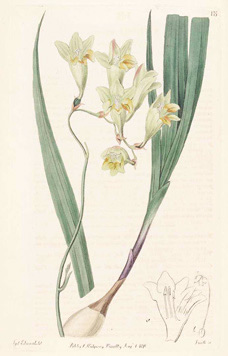Elusive Freesia
By Audrey Stallsmith

When Mr. Hathaway offered Freesia refracta alba bulbs to our “Band,” I looked over an immense pile of catalogues, in hopes to find it on sale, but no one offered it to the public; so I mustered up courage and sent for it. It’s no use for me to say it again—I want to see all the beautiful flowers I can, that God has planted on this earth before I go hence.
Mrs. Martha Crandall, Park’s Floral Magazine, 1885
I bought some freesia bulbs after they had been marked down in midsummer, with the vague idea that maybe they would bloom in the fall after the weather turned cooler. You can see I didn’t know much about freesias, but at least I planted them in a pot—just in case!
Because the bulbs had been sitting in the store so long, some didn’t come up at all, and slugs promptly ate the foliage of several others. By the time I was bringing in my other tropicals in mid-October, the three or four plants remaining still hadn’t bloomed, so I stuck their pot under the grow lights in a cool back room. I did at least know that freesias preferred chilly temperatures.
Since their floppy foliage still appeared pretty pitiful, I avoided looking at them. So I didn’t noticed until the last minute recently that a single stem on one of the plants was actually going to bloom. Those flowers were exquisite close up, white bells with lavender picotees and veins, and just what I needed in the depths of winter.
I really can’t say for sure what their scent was, since my sense of smell is less than acute. Also, oddly enough, some people can’t detect the odor of freesias—and I may simply be one of them. I did catch a faint fragrance, but it wasn’t citrus-like, as it is sometimes described. Tovah Martin probably came closer in The Essence of Paradise when she suggested the smell of baked plums.
In the areas where freesias are hardy, USDA zones 8 to 11, they can be planted outdoors in fall to bloom in spring. Because they prefer to remain quite dry during summer, they grow best in Mediterranean-like climates.
Despite their popularity as secondary blooms in bridal and other bouquets, freesias remain somewhat elusive flowers. Native to South Africa, they seem to have entered the horticultural world through a back door, as a few types floated among collectors for years in the early 1800’s before anybody took notice. Everybody thought they were either gladiolus, ixias, or tritonias. At the time refracta or refractus (“bent sharply backward”) was usually included in whatever name they were given, probably in reference to their bendy stems.
Even after the flowers received their own genus, in honor of a German doctor and botanist named Friedrich H. T. Freese, they didn’t attract attention until another German botanist, Max Leichtlin, discovered yellow ones around 1874 in the Botanic Gardens at Padua, Italy. Nobody remembered who had planted them there, so the type was named Freesia leichtlinii after Max instead, and gained widespread popularity, perhaps due to their strong fragrance.
Although called yellow, in photos they actually appear cream with yellow markings and backs flushed with maroon. Victorian gardeners welcomed the newcomer with enthusiasm, as those gardeners had a penchant for forcing almost anything indoors—and the cool conditions to please freesias.
For us modern gardeners in the north, it’s a good idea to plant them in late summer and leave them outdoors as long as possible in autumn before bringing them into the house. And to start with fresher bulbs than I did!
Tovah Martin recommends setting those bulbs close together in a pot, so the plants can help hold each other up, and adding a hoop of some sort for further support. ““For a few months,” she warns, “you’ll wonder why you are fussing over several pots of pathetically straggly grass. Then, in late January, you will wonder no more.”
Freesia refracta image is by S. Edwards, from the Botanical Register, courtesy of plantillustrations.org.








